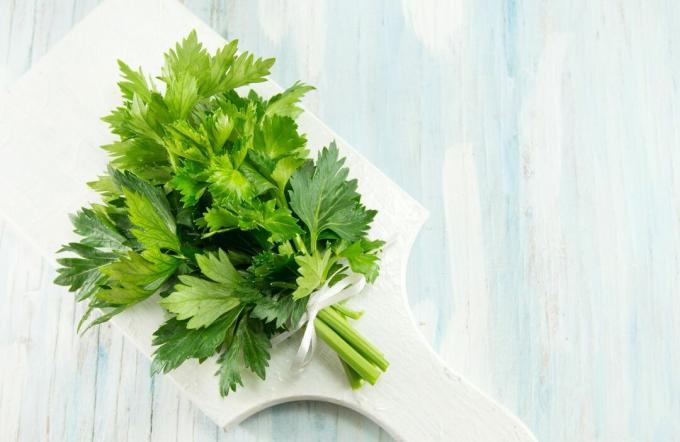Real celery occurs in the garden in different variations. But when is the best time to harvest & what are the storage options?

Harvest real celery properly
In the garden one encounters next to the celeriac (Apiumgraveolens var. Rapaceum) nor the perennial (Apiumgraveolens var. dulce) and cut celery (Apiumgraveolens var. secalinum). In addition to cultivation, these three celery varieties also have their own characteristics during harvest, which we will now describe in detail:

-
celery root
Celeriac is sensitive to frost and must therefore always be harvested before the first night frosts in October. If necessary, it can also be pulled out of the ground early on by the above-ground foliage. In order to achieve the best possible storage, it is advisable not to wash the tuber after harvesting, but only to wipe the soil. -
celery
The thickened petioles of celery can be harvested continuously and gradually. Depending on requirements, they are separated individually from the plant. It is also possible to harvest all of the celery at once. Then it is simply cut off just above the surface of the earth and the individual leaves remain together as a whole. The celery is less sensitive to cold and can therefore be left standing in mild winters and, if necessary, always be harvested fresh from the bed. -
cut celery
Cut celery is very similar to parsley. This also applies to the harvest. The aromatic foliage is simply cut off as needed and can be used directly.
We recommend the following types of celery:
- Celeriac Prince: Bolt-resistant celeriac with white flesh and high yield. Mildly aromatic taste.
- Celery Tango: Delighted by its delicate aroma. Ideal for snacks, salad, steaming and dipping.
- Sliced celery Gewone Snij: Spicy herb ideal for stews, soups and sauces. Suitable for tubs and perfect for growing on the balcony or terrace.
Store real celery properly
Depending on the variety of real celery that has found its place in the home garden, there are various ways of storing and preserving the harvest.

-
Store in the basement or refrigerator
Both celeriac and celery are good and should be kept in the refrigerator or in a dark cellar for a few weeks. If the consistency slowly but surely changes from crunchy to soft, the celery should be processed as soon as possible. -
Pickling in salt
If the celeriac is grated finely after peeling, the aroma can be preserved by mixing the fine graters with salt in a ratio of 1:1. In this way, the salt absorbs the aromas of the celery and the harvest from your own garden does not start to go moldy. -
Freeze
Stems and celeriac can be frozen perfectly. The celeriac simply needs to be peeled and chopped. The celery, on the other hand, must first be boiled for about three minutes after it has been cut into small pieces and then quenched with cold water. Only then can it find a place in the freezer after draining well. The freshly harvested green of the celery can also be frozen if chopped up. -
insertion
Celeriac can also be pickled. The tuber is cut up and boiled down in jars with a vinegar broth. In this way, your own harvest can be used for years. -
dry
Cut celery is very similar to parsley. However, the cut celery has a clear advantage: it can simply be dried without noticeably losing any of its spicy aroma.
With these tips, you can safely bring in your celery harvest and store it cleverly so that you can use celery from your own garden all year round.
Did you know that you can easily grow new vegetable plants from leftover celery? Here you will find useful information on the subject Reuse leftover vegetables.
